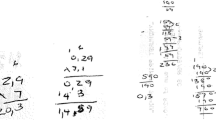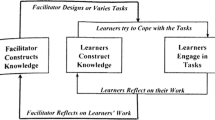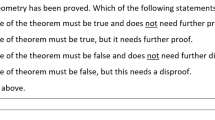Abstract
Teachers of mathematics orchestrate opportunities for interactions between learners and subject matter. Therefore, mathematics teachers need rich, multidimensional content knowledge for teaching mathematics, which incorporates knowledge of the subject matter, students, and teaching. Studying this mathematical knowledge for teaching (MKT) necessitates more than a unidirectional assessment. In this study, the mathematical knowledge for teaching reasoning and proving of two secondary mathematics teachers was investigated through classroom observations and clinical assessments. Results indicate that using MKT as a frame for examining classroom practice, in addition to assessing the MKT a teacher possesses in a clinical setting, provides an in-depth and innovative method for investigating MKT. The comparison of the two cases also identifies student positioning as a key mediating factor between MKT and opportunities to learn. Implications for using MKT as a lens for examining practice in teacher education are discussed.


Similar content being viewed by others
Notes
Our conception of proof in this article encompassed the acts of mathematical reasoning leading to informal and formal proof arguments, consistent with Stylianides and Stylianides’ (2006) conception of “reasoning-and-proving.”
In particular, the framework addresses what Ball et al. (2008) refer to as common and specialized content knowledge. Issues more commonly identified with pedagogical content knowledge, such as common student misconceptions, were beyond the scope of this general framework, as specific student thinking and misconceptions are highly dependent on, and interactive with, the mathematical content represented in the proof.
All names are pseudonyms.
All teachers in the project taught at least one section of geometry. To guard against effects from content knowledge unrelated to proof, a geometry context was selected for assessment tasks. Because the aspects of proof described in the MKT-P framework are content-agnostic, these items were appropriate to measure MKT related to proof.
In many intervals, more than one aspect of proof was discussed simultaneously. In these cases, intervals were coded with multiple aspects of the MKT-P framework, and a new interval was started when a new aspect was added or an aspect dropped from the discourse.
While these comments did relate to the proof and the comment at hand, they seemed intended to motivate students by suggesting that they were doing something challenging. Such comments lead us to consider the ways in which a teacher might situate proof as a part of the broader mathematical activity of the classroom to students—an interesting idea that is beyond the scope of this report.
Lucy’s description of forms of proof included both physical forms (paragraph proof, visual proof) and methods for proving (proof by counterexample, induction).
References
Balacheff, N. (1988). Aspects of proof in pupils’ practice of school mathematics. In D. Pimm (Ed.), Mathematics, teachers and children (pp. 216–235). London: Hodder & Stoughton.
Ball, D. L. (1988). Knowledge and reasoning in mathematical pedagogy: Examining what prospective teachers bring to teacher education. Unpublished doctoral dissertation, Michigan State University.
Ball, D. L., Bass, H., & Hill, H. C. (2004). Knowing and using mathematical knowledge in teaching: Learning what matters. Cape Town, South Africa: South African Association of Mathematics Science and Technology Education.
Ball, D. L., Lubienski, S., & Mewborn, D. (2001). Research on teaching mathematics: The unsolved problem of teachers’ mathematical knowledge. In V. Richardson (Ed.), Handbook of research on teaching (4th ed., pp. 433–456). Washington, D.C.: American Educational Research Association.
Ball, D. L., Thames, M. H., & Phelps, G. (2008). Content knowledge for teaching: What makes it special? Journal of Teacher Education, 59(5), 389–407.
Boaler, J. (1999). Participation, knowledge and beliefs: A community perspective on mathematics learning. Educational Studies in Mathematics, 40(3), 259–281.
Fennema, E., & Franke, M. L. (1992). Teachers’ knowledge and its impact. In D. A. Grouws (Ed.), Handbook of research on mathematics teaching and learning (pp. 147–167). New York: Macmillan.
Glaser, B. G. (1965). The constant comparative method of quantitative analysis. Social Problems, 12(4), 436–445.
Hanna, G. (1991). Mathematical proof. In D. Tall (Ed.), Advanced mathematical thinking (pp. 54–61). Dordrecht, The Netherlands: Kluwer.
Hanna, G. (1995). Challenges to the importance of proof. For the Learning of Mathematics, 15(3), 42–49.
Harel, G., & Sowder, L. (1998). Students’ proof schemes: Results from exploratory studies. In Conference Board of the Mathematical Sciences Issues in Mathematics Education (vol. III, pp. 234–283). Providence, RI: American Mathematical Society.
Healy, L., & Hoyles, C. (2000). Proof conceptions in algebra. Journal for Research in Mathematics Education, 31(4), 396–428.
Herbel-Eisenmann, B., & Wagner, D. (2007). A framework for uncovering the way a textbook may position the mathematics learner. For the Learning of Mathematics, 27(2), 8–14.
Hill, H. C., Rowan, B., & Ball, D. L. (2005). Effects of teachers’ mathematical knowledge for teaching on student achievement. American Educational Research Journal, 42(2), 371–406.
Knuth, E. J. (2002a). Secondary school mathematics teachers’ conceptions of proof. Journal for Research in Mathematics Education, 33(5), 379–405.
Knuth, E. J. (2002b). Teachers’ conceptions of proof in the context of secondary school mathematics. Journal of Mathematics Teacher Education, 5(1), 61–88.
Knuth, E. J., Choppin, J., Slaughter, M., & Sutherland, J. (2002). Mapping the conceptual terrain of middle school students’ competencies in justifying and proving. In D. S. Mewborn, P. Sztajn, D. Y. White, H. G. Weigel, R. L. Bryant, & K. Nooney (Eds.), Proceedings of the 24th Annual Meeting of the North American Chapter of the International Group for the Psychology of Mathematics Education (vol. 4, pp. 1693–1670). Athens, GA: Clearinghouse for Science, Mathematics, and Environmental Education.
Leinhardt, G. (1989). Math lessons: A contrast of novice and expert competence. Journal for Research in Mathematics Education, 20(1), 52–75.
Leinhardt, G. (2001). Instructional explanations: A commonplace for teaching and location for contrast. In V. Richardson (Ed.), Handbook of research on teaching (4th ed., pp. 333–357). New York: Macmillan.
Leinhardt, G., & Steele, M. D. (2005). Seeing the complexity of standing to the side: Instructional dialogues. Cognition and Instruction, 23(1), 87–163.
Lemke, J. L. (1983). Thematic analysis: Systems, structures, and strategies. Toronto: Canadian Semiotic Research Association.
Markovits, Z., & Smith, M. S. (2008). Cases as tools in mathematics teacher education. In D. Tirosh & T. Wood (Eds.), The international handbook of mathematics teacher education: Tools and processes in mathematics education (Vol. 2, pp. 39–64). Rotterdam: Sense Publishers.
Nasir, N. S. (2002). Identity, goals, and learning: Mathematics in cultural practice. Mathematical Thinking and Learning, 4(2), 213–247.
National Board for Professional Teaching Standards. (1997). Middle childhood and early adolescence/mathematics: Standards for National Board Certification. Washington, D. C.: National Board for Professional Teaching Standards.
National Council of Teachers of Mathematics. (1991). Professional standards for teaching mathematics. Reston, VA: NCTM.
National Council of Teachers of Mathematics. (2000). Principles and standards for school mathematics. Reston, VA: NCTM.
National Council of Teachers of Mathematics. (2009). Focus on high school mathematics: Reasoning and sense-making. Reston, VA: NCTM.
Shulman, L. S. (1986). Those who understand: Knowledge growth in teaching. Educational Researcher, 15(2), 4–14.
Steele, M.D. (2006). Middle grades geometry and measurement: Examining change in knowledge needed for teaching through a practice-based teacher education experience Unpublished Doctoral Dissertation, University of Pittsburgh.
Steele, M. D. (2008). Building bridges: Cases as catalysts for the integration of mathematical and pedagogical knowledge. In S. Friel & M. S. Smith (Eds.), Cases in mathematics teacher education: Tools for developing knowledge needed for teaching. Fourth Monograph of the Association of Mathematics Teacher Educators (pp. 57–72). San Diego: Association of Mathematics Teacher Educators.
Steele, M. D., Smith, M. S., & Hillen, A. F. (2011, February). Content-focused methods courses: Integrating pedagogy and mathematical content that is central to the 7-12 curriculum. Paper presented at the annual meeting of the Association of Mathematics Teacher Educators, Irvine, CA.
Stein, M. K., Baxter, J., & Leinhardt, G. (1990). Subject matter knowledge and elementary instruction: A case from functions and graphing. American Educational Research Journal, 27(4), 639–663.
Stein, M. K., & Lane, S. (1996). Instructional tasks and the development of student capacity to think and reason: An analysis of the relationship between teaching and learning in a reform mathematics project. Educational Research and Evaluation, 2, 50–80.
Stylianides, A. J. (2007). Proof and proving in school mathematics. Journal of Research in Mathematics Education, 38, 289–321.
Stylianides, A. J., & Ball, D. L. (2004, April). Studying the mathematical knowledge needed for teaching: The case of teachers’ knowledge of reasoning and proof. Paper presented at the Annual Meeting of the American Educational Research Association, San Diego, CA.
Stylianides, A. J., & Stylianides, G. J. (2006). Content knowledge for mathematics teaching: The case of reasoning and proving. In J. Novotná, H. Moraová, M. Krátká, & N. Stehliková (Eds.), Proceedings of the 30th Annual Conference of the International Group for the Psychology of Mathematics Education (vol. 5, pp. 201–208). Prague, Czech Republic.
Stylianides, G. J., & Stylianides, A. J. (2009). Facilitating the transition to proof in mathematics teacher education: The limitations of empirical arguments and the importance of proof. Journal for Research in Mathematics Education, 40(3), 314–352.
Stylianides, A. J., Stylianides, G. J., & Philippou, G. N. (2002). University students’ conceptions of empirical proof and proof by counterexample. In M. Tzekaki (Ed.), Proceedings of the 5th Panellenian Conference on “Didactics of Mathematics and Computers in Education” (Thessaloniki, 2001) (pp. 277–282). Aristotle University of Thessaloniki, Greece.
Stylianides, A. J., Stylianides, G. J., & Philippou, G. N. (2004). Undergraduate students’ understanding of the contraposition equivalence rule in symbolic and verbal contexts. Educational Studies in Mathematics, 55, 133–162.
Stylianides, A. J., Stylianides, G. J., & Philippou, G. N. (2005). Prospective teachers’ understanding of proof: What if the truth set of an open sentence is broader than that covered by the proof? In H. L. Chick & J. L. Vincent (Eds.), Proceedings of the 29th Annual Meeting of the International Group for the Psychology of Mathematics Education. Melbourne, Australia.
Wilson, M. R., & Lloyd, G. M. (2000). Sharing mathematical authority with students: The challenge for high school teachers. Journal of Curriculum and Supervision, 15(2), 46–69.
Winicki-Landman, G. (1998). On proofs and their performance as works of art. Mathematics Teacher, 91(8), 722–725.
Yackel, E., & Hanna, G. (2003). Reasoning and proof. In J. Kilpatrick, W. G. Martin, & D. Schifter (Eds.), A research companion to principles and standards for school mathematics (pp. 22–44). Reston, VA: National Council of Teachers of Mathematics.
Author information
Authors and Affiliations
Corresponding author
Rights and permissions
About this article
Cite this article
Steele, M.D., Rogers, K.C. Relationships between mathematical knowledge for teaching and teaching practice: the case of proof. J Math Teacher Educ 15, 159–180 (2012). https://doi.org/10.1007/s10857-012-9204-5
Published:
Issue Date:
DOI: https://doi.org/10.1007/s10857-012-9204-5




